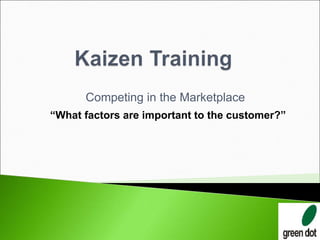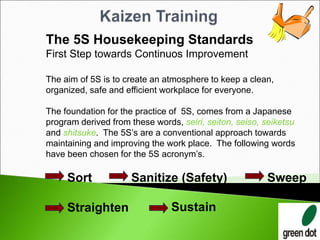Kaizen: The Art of Continuous Improvement"
- 1. Competing in the Marketplace 1 “What factors are important to the customer?”
- 2. 2 TIME: The single best indicator of competitiveness Customer Lead Time / Delivery Time Working to reduce or minimize each of these times can make your company more valuable to both its internal and external customers. Set-up or Change-over Time Product Development Time Manufacturing Cycle Time
- 3. 3 Shrinking Lead Times Order Lead Times Manufacturing Lead Times Delivery Lead Times Manufacturing Lead Times Order Lead Times Delivery Lead Times Reducing the overall time from receiving the order to delivering the product makes your company more responsive to the customer. This can become the deciding factor when the customer makes their selection. As can be seen, manufacturing is only one part of the entire process. Inputting, processing, and issuing orders is an area for improvement, as well as, assembly, loading and delivery to the customer`
- 4. 4 Where’s the Time in Lead Time This timeline represents an overall lead-time, with very little time spent on adding value to the product. Non-Value Added Time (NVA) 99% of Total Lead time Value Added Time (VA) 1% Improvement Efforts Concentrated on reducing VA time, with no attention given to NVA. Non-Value Added Time (NVA) 99% of Total Lead time VA 1/2 % Results of Common Improvement efforts, did not improve response time. VA time is reduced, but, the costs for those improvements in lead time was substantial. Common
- 5. 5 Where’s the Time in Lead Time NVA Time 95% of Total Lead time VA 5% When we look at attacking the NVA Activities in the Timeline and compare that to the original timeline: Non-Value Added Time (NVA) 99% of Total Lead time Value Added Time (VA) 1% This shows a 5X improvement in lead time Great Job!! Greatest Opportunities are actually here!
- 6. 6 Different Types of Activities Being able to tell the difference between NVA and VA activities is an important step in the Improvement Process. Value Added Activity (VA) An activity that changes raw material to meet customer expectations. Non Value Added Activity (NVA) Those activities that take time, or occupy space but do not add to the value of the product. You must ask yourselves “Would you as a customer be willing to pay for any NVA activity being performed to that NEW 4x4 Pickup you just ordered?”
- 7. 7 Some examples NVA Activities: Walking Waiting on machine cycle Transporting parts Generating useless reports THE GOAL IS TO ELIMINATE THE NON-VALUE ADDED ACTIVITIES. Unnecessary motion Unnecessary stock on hand
- 8. 8 A definition: Destroy, in our minds, the concepts and techniques of manufacturing that we practice today. Create a vision of what our production system and manufacturing techniques should be. Carry out that Vision by breaking through the status quo. We must avoid the urge to discover more sophisticated and technological solutions to tasks we shouldn’t be doing at all.
- 9. 9 Basic Rules for Change Keep an open mind to change No such thing as a dumb question or idea Avoid spending money (Capital expense should be a last resort) Think about how to do it, NOT why it can’t be done Maintain a positive attitude Don’t’ make excuses & question current practices Just do it!! Have Fun!!!
- 10. 1 Steps on Team Development Forming This is the development of a multi-functional team with a variation of backgrounds and knowledge Norming Stage where the group agrees how to operate as a team Storming Open & honest discussion, also brainstorming Performing Agreement on solutions & taking action Adjourning Closing on the continuos improvement process after 30 days
- 11. 1 What is TAKT Time? TAKT time is how many minutes or seconds are needed to make one part when considering the daily volumes, to be produced in that workcell and the total time available to perform the job. TAKT time is NOT the time it takes to manufacture the product. It is based on customer demand. Who is the customer? The next operation Customer orders
- 12. 1 TAKT Time Calculation Production Time Available / Period Number of Required Units / Period TAKT Production Time Available / Period (one shift): Breaks - 2 @ 10 minutes Shift Time ( 8 hrs. ) Clean-up at end of shift Production Time Available: - 20 mins. 480 mins. - 5 mins. 455 mins. Units Required / Period (one shift): 10,500 Units Sold Monthly 21 Working shifts / month 27,300 secs. or 500 Required units / shift TAKT Time: 27,300 secs / shift 500 units / shift 54.6 secs.
- 13. 1 The 5S Housekeeping Standards First Step towards Continuos Improvement The aim of 5S is to create an atmosphere to keep a clean, organized, safe and efficient workplace for everyone. The foundation for the practice of 5S, comes from a Japanese program derived from these words, seiri, seiton, seiso, seiketsu and shitsuke. The 5S’s are a conventional approach towards maintaining and improving the work place. The following words have been chosen for the 5S acronym’s. Sort Sustain Sanitize (Safety) Straighten Sweep
- 14. 1 Meaning of the 5S’s Sort Straighten Sweep (Scrubbing clean) Examine everything at the workplace & identify what is needed and what can be discarded Organizing the way things are put away with efficiency, quality, and safety in mind. Need to decide where and how things should be put away and what rules should be obeyed to insure that it is maintained. Sweeping, scrubbing and cleaning of the building, machines, fixtures & tools so that all areas of the workplace are neat & tidy. This leads to early detection of mechanical problems before they become major breakdowns. Machines cry!
- 15. 1 Sanitize (Safety) Sustain (Standardize) Meaning of the 5S’s Insuring that each workplace is properly designed for safety. This is to protect every member from the dangers during the performance of their assigned tasks. Developing the practice necessary to continually participate in the 5S process. This requires that each of the S’s become a personal habit. This is the most difficult of the 5S’s, but it is the most important factor in achieving long term success. Establishing routines and procedures for maintaining and improving on the first four (S’s), incorporating visual management tools.
- 16. 1 WASTE
- 17. 1 Do MORE with LESS Waste Productivity Staffing Productivity
- 18. 1 SHIFT MINDSET CURRENT THINKING REQUIRED THINKING WASTE NOT DEFINED REACT TO LARGE EXAMPLES REACTIVE IMPROVEMENT WASTE IS "TANGIBLE” IDENTIFY MANY SMALL OPPORTUNITIES -LEADS TO LARGE OVERALL CHAGE CONTINUOUS IMPROVEMENT WASTE TYPES OF WASTE Correction Processing Motion Waiting Inventory Transportation Over- Production
- 19. 1 1. Transportation - Transporting 1. Transportation - Carrying farther than necessary or Tools to Point of Use temporarily locating, filing, stacking and moving parts (people, paper, information) is waste. 2. Correction - Doing something 2. Correction - Redo an Activity over is waste. Because of Error 3. Overproduction - Generating 3. Overproduction - Number of excess paper or information, or Copies generating information or paper too soon in a process is waste. Definition Example ELEMENTS OF WASTE
- 20. 2 4. Motion - Unnecessary work 4. Motion - Tools in drawers movements are a form of waste. 5. Waiting - Waiting for people, 5. Waiting - Meetings to start paper and information is waste - it stops work. 6. Inventory - Too much of 6. Inventory - Supplies anything is waste. 7. Processing - this is waste in 7. Processing - Typed when the process itself. Redundant handwritten would be activities sufficient Definition Example ELEMENTS OF WASTE
- 21. 2 Standards Enforce Inspect . Stabilize Identify Waste Problem Solve Standardize • Process requires ongoing inspection and enforcement to ensure “Standardized Work” is being followed • Process does not improve automatically - Following standards will only maintain, not improve, the process. - Improvement focuses on the entire process.




















